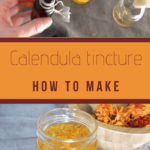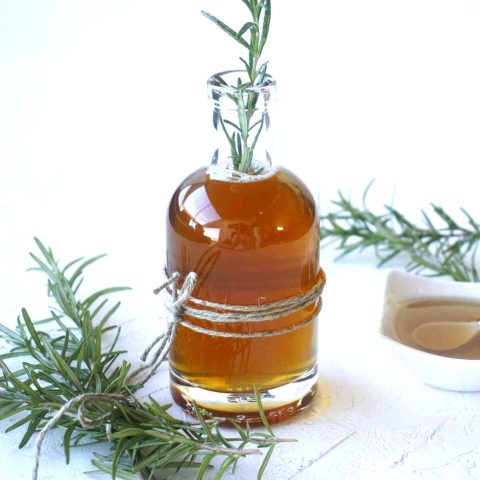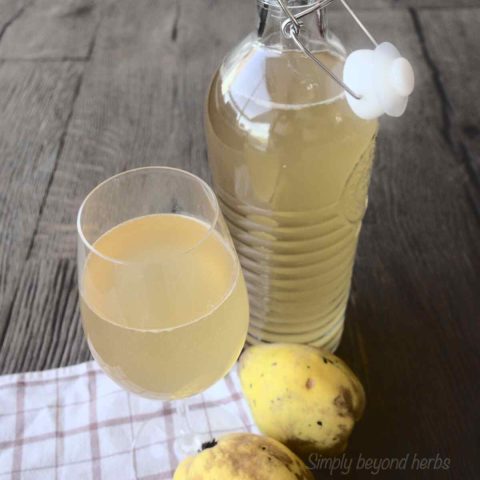Calendula tincture is an effective herbal formulation with a large spectrum of uses. This calendula extract alleviates inflammations, sore throat or clean scrapes, rashes, or stings.
It makes a great addition to your first aid kit whenever you go camping, hiking, or exposed to the outdoors.

I may make a commission from links in this post. That means that if you make a purchase, I will receive a small commission at no extra cost to you. See more
Calendulas (Calendula officinalis or pot marigolds) decorate gardens with orange and yellow flowers that shine and light up every corner. In addition, they are an integral part of the medicine cabinet of any herbalist.
Easy to grow from seeds, calendulas belong to one of the most popular herbs used internally and externally in herbal medicine.
I love to use calendulas in skincare to make calendula oil, salve or calendula cream. Moreover, they are very effective in haircare thus using them to make these shampoo bars or hair growth oil.
However, if you want to use their power internally, you can make a traditional herbal tea or turn them into a calendula tincture.

What is calendula tincture?
tincture of calendula is a concentrated extract made by soaking calendula petals in alcohol for several weeks. A slow maceration enables pot marigold to relieve its active substances into a solvent. A few drops of tincture contain a potent concentrate with long shelf life.
Making calendula tincture is a great way to implement calendula in your daily routine. With its large spectrum of uses, calendula extract is a handy healer one can carry anywhere.
Other tinctures you may want to try:
spruce tips tincture
Stinging nettle roots tincture
Herbal tincture has many advantages
- simple dosing
- fast onset of action – ethanol helps faster absorption of active substances into the blood and the whole body
- concentrated tinctures can be diluted in water to hide the taste
- compact
- portable – convenient for travel and for carrying in a handbag so you can administer your herbs wherever you are
- Tinctures are a great option for those who lead a busy lifestyle and don’t have time to prepare herbal teas daily.
- long shelf life (ethanol acts as a preservative) – up to 5 years

Ingredients
The process of making a marigold tincture recipe is easy and requires just two ingredients
Calendula petals
use dry or fresh calendula petals.
Chop the petals into smaller pieces to increase the surface area for the maceration and get the maximum medicinal properties from the herb.
You can also grind them or bruise them in a mortar and pestle to help maximize the extraction process.
Alcohol
select alcohol 40% = 80 proof ethanol, ethyl alcohol or grain spirit,
Alternatively, use vodka, rum, or brandy
Ratio
the ratio for dry herbs: 1:5 (one weight part of the calendula petals and 5 weight part of alcohol)
the ratio for fresh herbs 1:2

Tools
Sterilized glass jar with a plastic lid
Glass funnel
cheesecloth
How to make calendula tincture
First step
Place calendula petals in a sterilized glass jar
Second step
Pour over alcohol of your choice to cover the petals completely You might have to push down the petals a bit and some still may float, but that’s ok.
Third step
Close the jar tightly. If you don’t use jar with plastic lid place parchment paper between the lid and the jar to prevent the rubber seal from dissolving
Fourth step
Label the jar and place your jar in a cool dark place. Shake it occasionally. Check the alcohol level and make sure the herb is submerged completely. If needed add additional alcohol.
Let calendula release their medicinal properties for 4-6 weeks
Fifth step
Strain the calendula petals from the alcohol. Ideally, pour the tincture into a dark bottle with a dropper.

Sixth step
Label the bottle
Benefits of marigold tincture
Calendula tincture reduces inflammation of the mucous membranes of the mouth and sore throat. (1)
Tincture of calendula soothes a sore throat and stops infections, laryngitis and tonsillitis, coughs, dryness of the lungs, and digestive upsets (2)
Similarly, works this violet sore throat spray.
Cleanse lymphatic system
The lymph is filtering and eliminating waste products and bacteria and therefore helps keep our immune system strong. Tincture of calendula raises immunity by stimulating lymphatic drainage (3)
ease cramps
its spasmolytic effect is used to ease abdominal cramps and constipation (4)
wound healing
You can apply it locally to reduce pain and swelling (inflammation) and to treat poorly healing wounds and leg ulcers. Or apply to the skin (used topically) for nosebleeds, varicose veins, hemorrhoids, and inflammation of the rectum (5)
This marigold tincture recipe has excellent antimicrobial activity against fungi and most of the bacteria tested while comparing with Fluconazole (6)
ease acne
Calendula tincture contains astringents such as tannins that are used topically on the skin to ease acne. Calendula tincture reduces inflammation and prevents the further spread of infection over the skin. It also promotes rapid healing of the skin (7).
Calendula tincture uses
for gargling
to soothe a sore throat and stop infections
fill the clean spray bottle with two tablespoons of calendula tincture, two tablespoons of raw honey or Manuka honey, and one tablespoon of warm water. Mix it well. Apply three times a day with 2-3 sprays in affected areas.
Calendula mouthwash
for infected gums and other mouth problems.
You can dilute a few drops of tincture in a glass of water and use as a mouthwash for sore, inflamed throat and gums.
ease pain
To ease abdominal and menstruation pain use 20 drops 3 times a day of tincture. Apply in the forms of drops under the tongue or drops diluted in juice, water or tea
Calendula tincture for skin
acne
You can apply directly on the skin to ease acne or impetigo-simply
add a few drops of the tincture to any kind of neutral skin cream or face wash you use every day just before applying it to your face
Alternatively, make acne mask from calendula tincture, cinnamon, and essential oils
wound healing
apply locally on wounds, varicose veins, hemorrhoids, and inflammation of the rectum (hemorrhoids)
in a bath
Calendula tincture can be added to bath water or a hair rinse to help itching or irritated scalp and skin conditions.

To create a non-alcoholic tincture, replace the alcohol with Apple Cider Vinegar.
Pour the apple cider vinegar over the herbs and cover them by 2-3 inches, and then seal the jar with a tight-fitting lid. Then, place the jar in a warm, sunny spot, and let the herbs soak (macerate) for 4 to 6 weeks, shaking daily.
This vinegar-based tincture will keep for at least 1 year.
The medicinal compounds in tinctures are both light-sensitive and air-sensitive, so they may break down with prolonged light exposure. If kept correctly, tincture shelf life is more than 5 years.

Calendula tincture

Calendula tincture has a large spectrum of uses from sore throat inflammations to healing open wounds and hemorrhoids. Its spasmolytic effect helps treat abdominal cramps and constipation.
Materials
- organic calendula petals
- Grain alcohol of your choice 60%
Tools
Instructions
- Place calendula petals in the glass jar
- Select alcohol of your choice and cover the petals completely
- Close the jar tightly. Place parchment paper between the lid and the jar to prevent the rubber seal from dissolving
- Label the jar
- Place your jar in a cool dark place and shake it occasionally. Check the alcohol level and make sure the herb is submerged completely. If needed add additional alcohol.
- Let calendula release their medicinal properties for 4-6 weeks
- Strain the calendula petals from the alcohol. Ideally pour the tincture into a dark bottle with dropper.
- Label the bottle with CALENDULA TINCTURE with 60 % ethanol and date
Recommended Products
As an Amazon Associate and member of other affiliate programs, I earn from qualifying purchases.
-
 Glass Mason Jars with plastic Lids
Glass Mason Jars with plastic Lids -
 Goodcook Cheesecloth, One Pack, White
Goodcook Cheesecloth, One Pack, White -
 2Pcs Pink Glass Essential Oil Dropper Bottles Containers Empty Round Bottles with Glass Eye Dropper Dispenser for Transfer Storing Oils Perfume Aromatherapy Lotion Cosmetic Sample Liquid (100ML)
2Pcs Pink Glass Essential Oil Dropper Bottles Containers Empty Round Bottles with Glass Eye Dropper Dispenser for Transfer Storing Oils Perfume Aromatherapy Lotion Cosmetic Sample Liquid (100ML) -
 Young4us Glass Funnel Set, 4 Pcs Lab Borosilicate Glass Funnels, 100mm (170mm Length), 75mm (130mm), 50mm (90mm) & 40mm (70mm) Diameter
Young4us Glass Funnel Set, 4 Pcs Lab Borosilicate Glass Funnels, 100mm (170mm Length), 75mm (130mm), 50mm (90mm) & 40mm (70mm) Diameter
Calendula in recipes, remedies and skincare
Calendula recipes for food, health, beauty
Facial Mask with calendula to treat acne
This homemade natural facial mask designed specifically for acne helps to block the flow of sebum and treat the acne bacteria that provoke the formation of acne lesions with its antimicrobial and anti-inflammatory agents.
Calendula Honey salve recipe
This healing calendula salve does not only moisturize your skin but also create a barrier that protects your hands against the cold wet conditions and leave them smooth and silky.
Best diaper cream for rash recipe
This homemade diaper rash cream soothes and relieves rash discomfort by creating a protective barrier allowing the skin to heal. Made by natural ingredients, this rich and thick diaper cream creates an optimal environment for delicate baby skin.























Oh wow! I could use this for a lot of the reasons you listed. And it’s so simple to make. Thanks for compiling this post!
Great ideas. I make this tincture with glycerin and find it is wonderfully good in taste as well as medicinally sound. I grow my own flowers so it is easy to make. Thanks for sharing!
Calendula is one of my favorite flowers/herbs, but I never thought of making a tincture with it. Great information in this post and so many ways to use the tincture! I love using natural remedies and may have to try this one out.
I’ve never thought of ingesting calendula! I always just add it to salves and lip balms. Thanks for this information! Another reason to grow more calendula this year.
Can an alcohol tincture be added when heading oils of the salve so the alcohol will evaporate and just the medicinal qualities left behind?
If so, what is the recommended ratio?
In order for alcohol to evaporate you need to warm up the oils up to 80 degrees celsius and that would destroy all medicinal benefits of infused oil. A much better alternative is to use glycerin instead of alcohol if you want to avoid using alcohol.
Luck can never last a lifetime
I made a calendula tincture a few months ago. I now have a lot of white stuff at the bottom of my jar. I’m not sure if it’s mold or not – hard to find info on the net about what mold in tinctures looks like. I used fresh flowers including the centre – so I’m wondering if that’s the problem? It was 80 proof vodka.
I also made a salve from dried calendula flowers and that turned out amazing!
Hi Monique, it could be mucilage, calendula has some. The more water you use to make the tincture, the more gloopy it is. You said you used 80 proof vodka which is 40 % alcohol and 60 % of water. This is why I use 60 % alcohol.
Please email me how to make calendula salve. Thank you.
Donna Wall
Hi Donna,
I made this healing calendula salve with honey https://simplybeyondherbs.com/calendula-honey-salve-recipe/ that is ideal for dry hands in cold autumn/ winter time for people that work manually in the garden, frequently wash their hands or use harsh cleaners.
is there a recipe for salve from TINCTURE
Hi, you can follow the this calendula salve recipe. https://simplybeyondherbs.com/calendula-honey-salve-recipe/ and add a 20 drops of calendula tincture into melted beeswax.
Remove from heat and let it cool slightly without solidifying.
I’ve seen many calendula tincture recipes that say it can be used topically. Call me crazy, but since they are all made with 40% alcohol (or apple cider vinegar), when applied to scrapes/minor wounds/raw or tender skin, I imagine the burn will be acute! What is your personal experience?
Hi Caitlin, I would only advise using the alcohol based tincture on minor wounds, such as cuts or scrapes. Anything deeper, such as deep lacerations or burns, should be treated with a milder disinfectant, such as betadine and apply healing calendula salve instead.